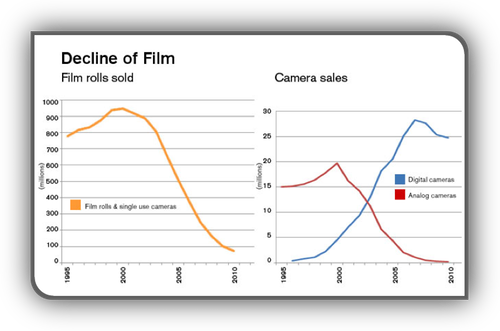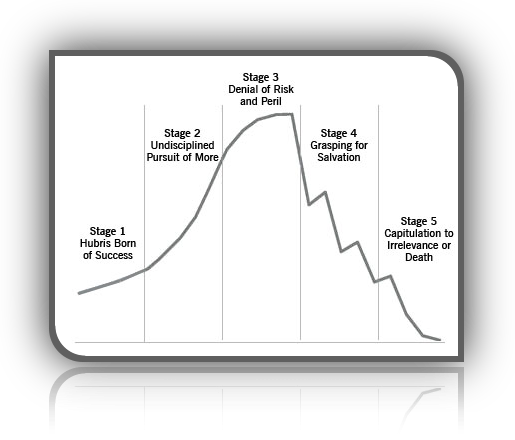The “shakeout” sets in as soon as the “window” closes.
And the majority of ventures started during the “window” period do not survive the shakeout, as has already been shown for such high-tech industries of yesterday as railroads, electrical apparatus makers, and automobiles.
As these lines are being written, the shakeout has begun among microprocessor, minicomputer, and personal computer companies—only five or six years after the “window” opened.
Today, there are perhaps a hundred companies in the industry in the United States alone.
Ten years hence, by 1995, there are unlikely to be more than a dozen left of any size or significance.
But which ones will survive, which ones will die, and which ones will become permanently crippled—able neither to live nor to die—is unpredictable.
In fact, it is futile to speculate.
Sheer size may ensure survival.
But it does not guarantee success in the shakeout, otherwise Allied Chemical rather than DuPont would today be the world’s biggest and most successful chemical company.
In 1920, when the “window” opened for the chemical industry in the United States, Allied Chemical looked invincible, if only because it had obtained the German chemical patents which the U.S. government had confiscated during World War I.
Seven years later, after the shakeout, Allied Chemical had become a weak also-ran.
It has never been able to regain momentum.
No one in 1949 could have predicted that IBM would emerge as the computer giant, let alone that such big, experienced leaders as G.E. or Siemens would fail completely.
No one in 1910 or 1914 when automobile stocks were the favorites of the New York Stock Exchange could have predicted that General Motors and Ford would survive and prosper and that such universal favorites as Packard or Hupmobile would disappear.
No one in the 1870s and 1880s, the period in which the modern banks were born, could have predicted that Deutsche Bank would swallow up dozens of the old commercial banks of Germany and emerge as the leading bank of the country.
That a certain industry will become important is fairly easy to predict.
There is no case on record where an industry that reached the explosive phase, the “window” phase, as I called it, has then failed to become a major industry.
The question is, Which of the specific units in this industry will be its leaders and so survive?
This rhythm—a period of great excitement during which there is also great speculative ferment, followed by a severe “shakeout”—is particularly pronounced in the high-tech industries.
In the first place, such industries are in the limelight and thus attract far more entrants and far more capital than more mundane areas.
Comments by Warren Buffett.
Also the expectations are much greater.
More people have probably become rich building such prosaic businesses as a shoe-polish or a watchmaking company than have become rich through high-tech businesses.
Yet no one expects shoe-polish makers to build a “billion-dollar business,” nor considers them a failure if all they build is a sound but modest family company.
(Managing the Family Business: see December 28 and 29 in The Daily Drucker)
High tech, by contrast, is a “high-low game,” in which a middle hand is considered worthless.
And this makes high-tech innovation inherently risky.
But also, high tech is not profitable for a very long time.
The world’s computer industry began in 1947-48.
Not until the early 1980s, more than thirty years later, did the industry as a whole reach break-even point.
To be sure, a few companies (practically all of them American, by the way) began to make money much earlier.
And one, IBM, the leader, began to make a great deal of money earlier still.
But across the industry the profits of those few successful computer makers were more than offset by the horrendous losses of the rest; the enormous losses, for instance, which the big international electrical companies took in their abortive attempts to become computer manufacturers.
And exactly the same thing happened in every earlier “high-tech” boom—in the railroad booms of the early nineteenth century, in the electrical apparatus and the automobile booms between 1880 and 1914, in the electric appliance and the radio booms of the 1920s, and so on.
One major reason for this is the need to plow more and more money back into research, technical development, and technical services to stay in the race.
High tech does indeed have to run faster and faster in order to stand still.
This is, of course, part of its fascination.
But it also means that when the shakeout comes, very few businesses in the industry have the financial resources to outlast even a short storm.
This is the reason why high-tech ventures need financial foresight even more than other new ventures, but also the reason why financial foresight is even scarcer among high-tech new ventures than it is among new ventures in general.
(Find “financial foresight” in Innovation and Entrepreneurship and see chapter 3 in The Changing World of the Executive)
There is only one prescription for survival during the shakeout: entrepreneurial management (described in Chapters 12-15).
What distinguished Deutsche Bank from the other “hot” financial institutions of its time was that Georg Siemens thought through and built the world’s first top management team.
What distinguished DuPont from Allied Chemical was that DuPont in the early twenties created the world’s first systematic organization structure, the world’s first long-range planning, and the world’s first system of management information and control.
Allied Chemical, by contrast, was run arbitrarily by one brilliant egomaniac.
But this is not the whole story.
Most of the large companies that failed to survive the more recent computer shakeout — G.E. and Siemens, for instance—are usually considered to have first-rate management.
And the Ford Motor Company survived, though only by the skin of its teeth, even though it was grotesquely mismanaged during the shakeout years.
Entrepreneurial management is thus probably a precondition of survival, but not a guarantee thereof.
And at the time of the shakeout, only insiders (and perhaps not even they) can really know whether a knowledge-based innovator that has grown rapidly for a few boom years is well managed, as DuPont was, or basically unmanaged, as Allied Chemical was.
By the time we do know, it is likely to be too late.
Innovation and Entrepreneurship


![]()
